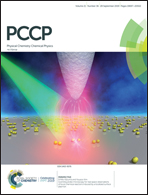Effects of Se substitution and transition metal doping on the electronic and magnetic properties of a MoSxSe2−x/h-BN heterostructure†
Abstract
The van der Waals heterostructures created by stacking two monolayer semiconductors have been rapidly developed experimentally and exhibit various unique physical properties. In this work, we investigate the effects of Se atom substitution and 3d-TM atom doping on the structural, electronic, and magnetic properties of the MoSe2/h-BN heterostructure, by using first-principles calculations based on density functional theory (DFT). It is found that Se atom substitution could considerably enhance the band gaps of MoSe2/h-BN heterostructures. With an increase in the substitution concentration, the energy band changes from an indirect to a direct band gap when the substitution concentration exceeds a critical value. For 3d-TM atom doping, it is shown that V-, Mn-, Fe-, and Co-doped systems exhibit a half-metallic state and magnetic behavior, while there is no spin polarization in the Ni-doped case. The results provide a theoretical basis for the development of diluted magnetic semiconductors and spin devices based on the MoSxSe2−x/h-BN heterostructure.


 Please wait while we load your content...
Please wait while we load your content...